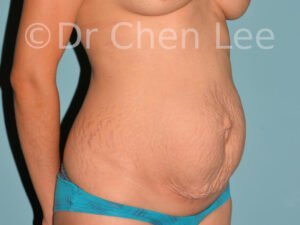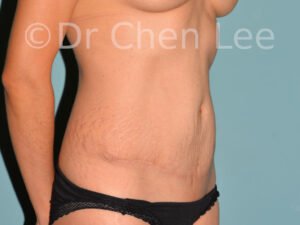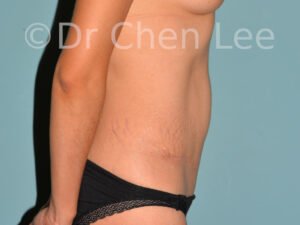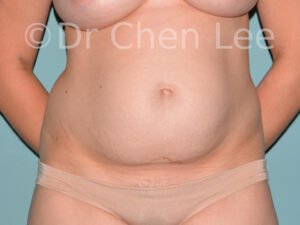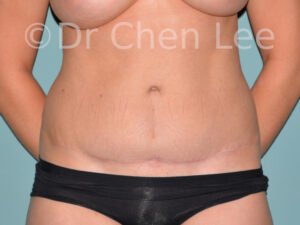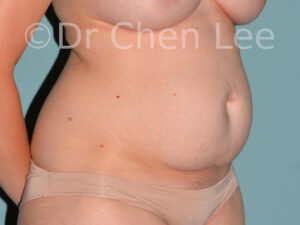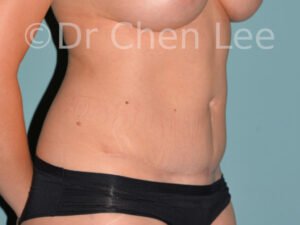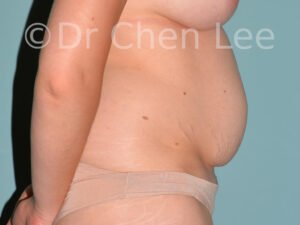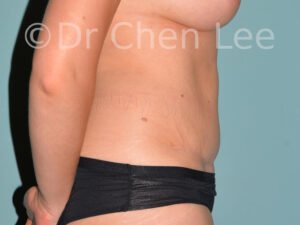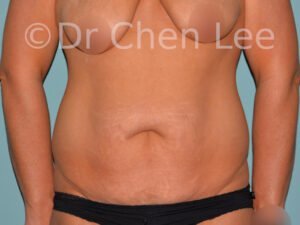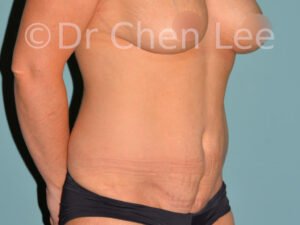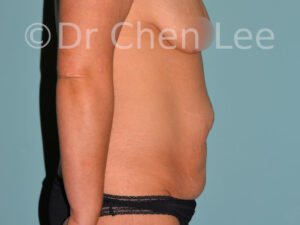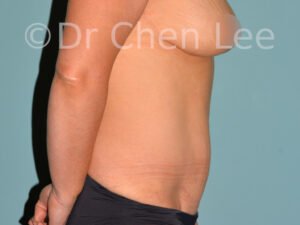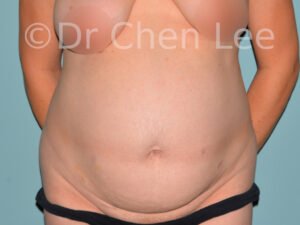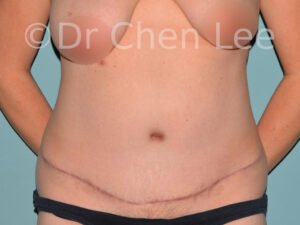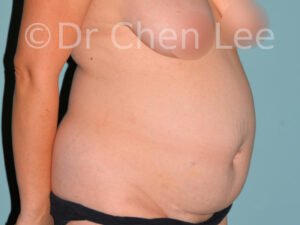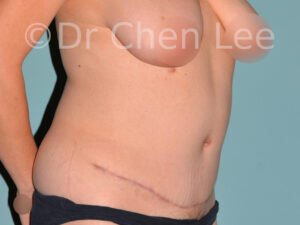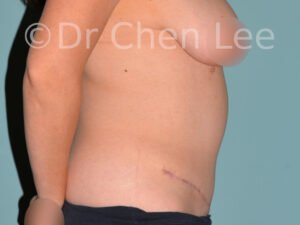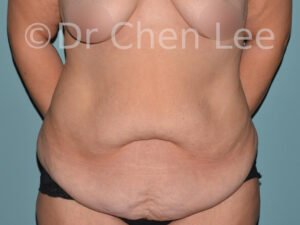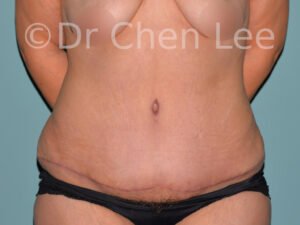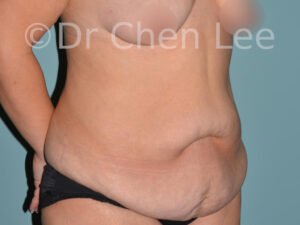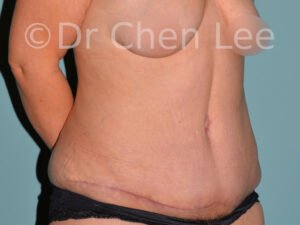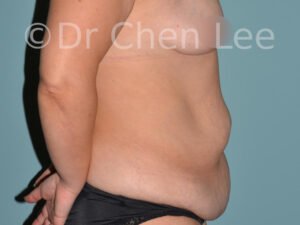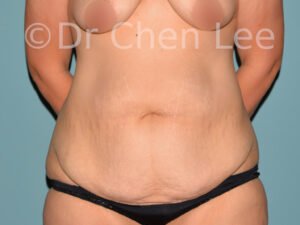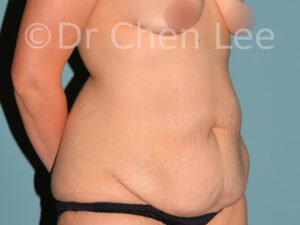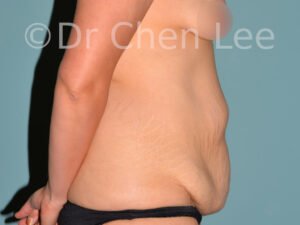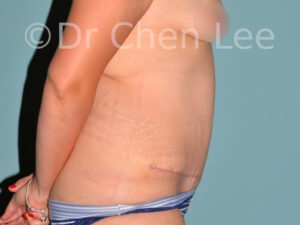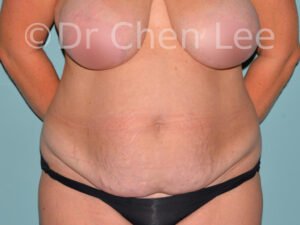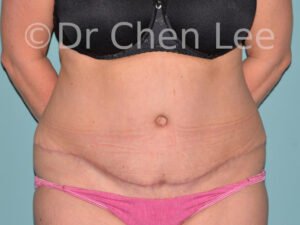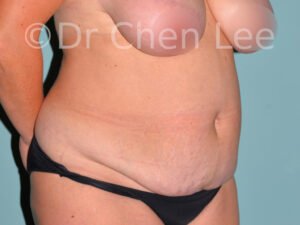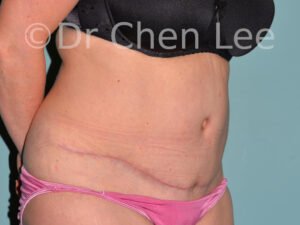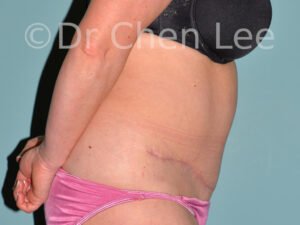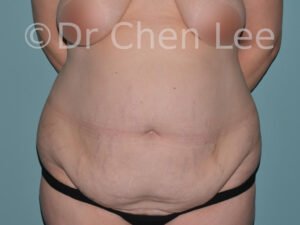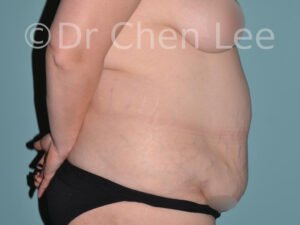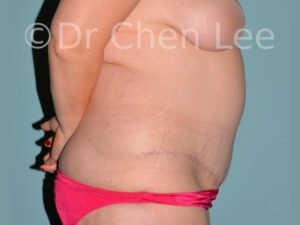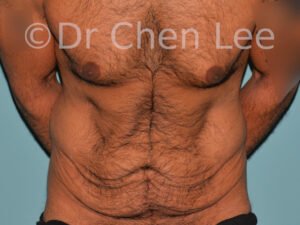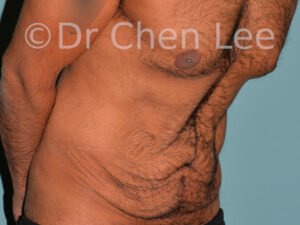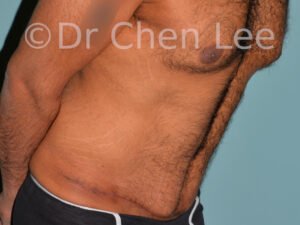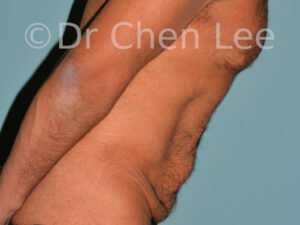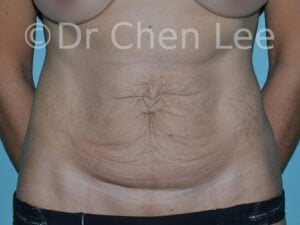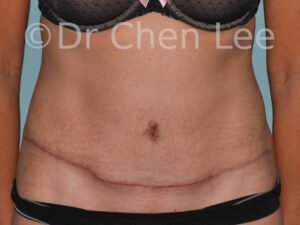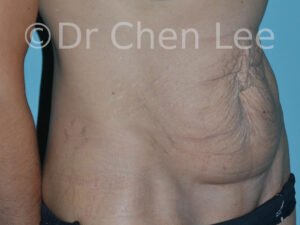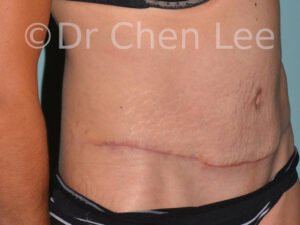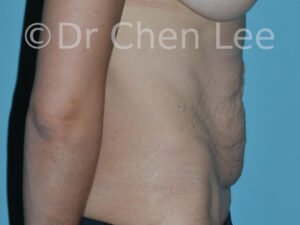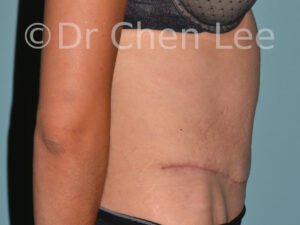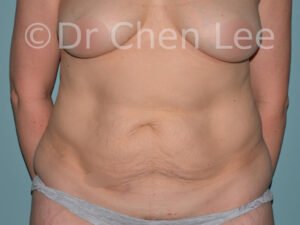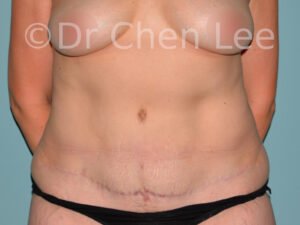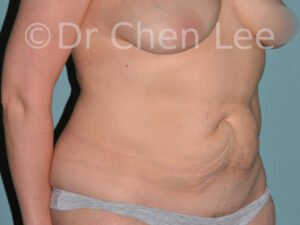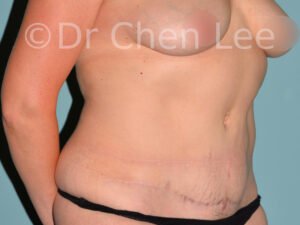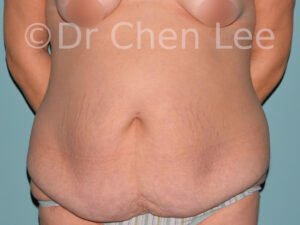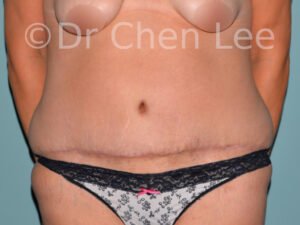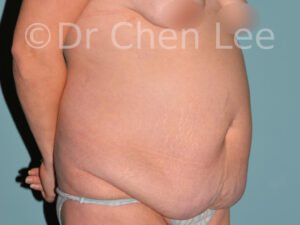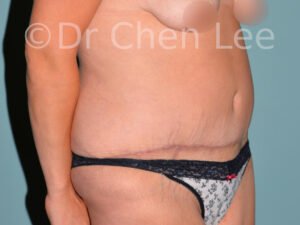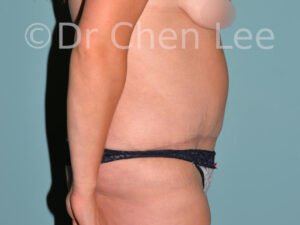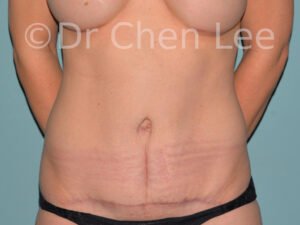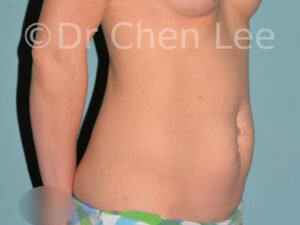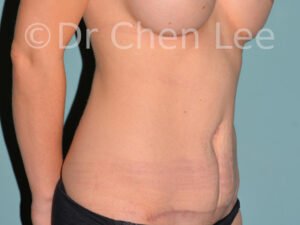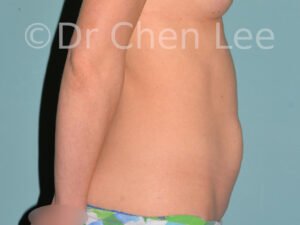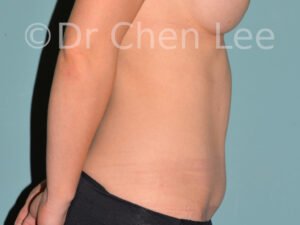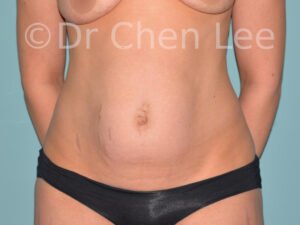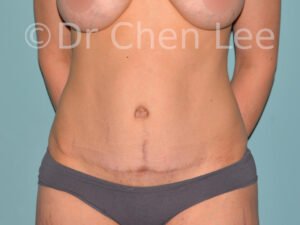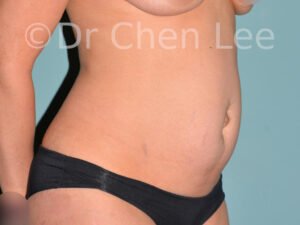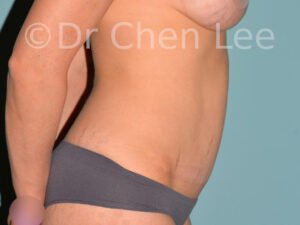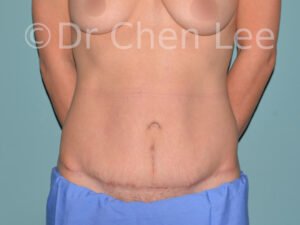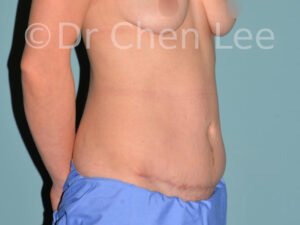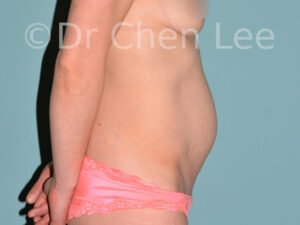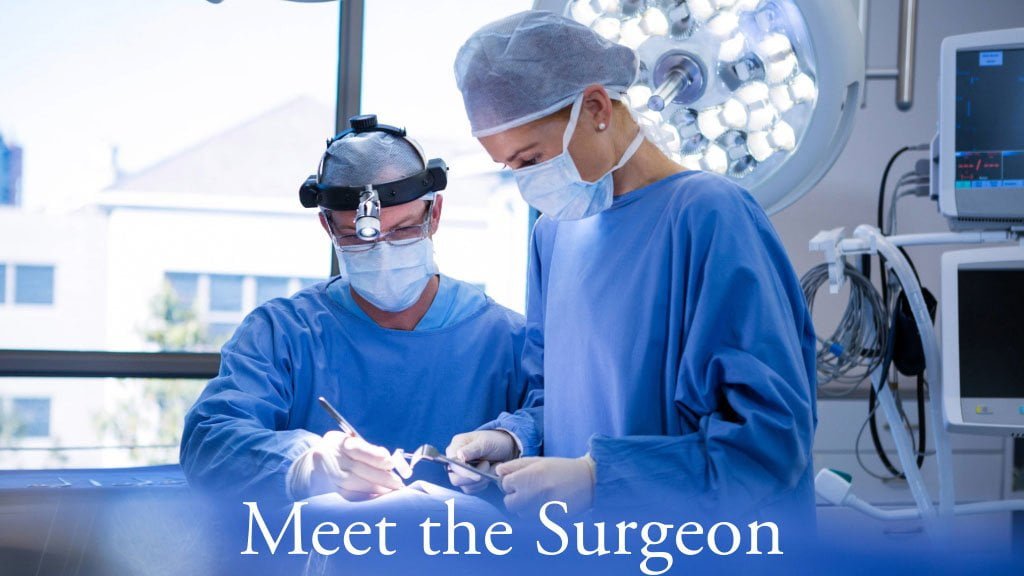Abdominoplasty | Tummy Tuck
With abdominoplasty, you can get the flat stomach you’ve always dreamed of!
Abdominoplasty known also as a tummy tuck is a surgical procedure that tightens the muscles and removes excess skin and fat from the abdomen. Separated muscles medically known as diastasis recti and hernias are often repaired during abdominoplasty surgery. Dramatic improvement of the abdominal contour is possible. The scars from the incisions are camouflaged in natural body folds and hidden by underwear.
Abdominoplasty – The Essentials
During your tummy tuck consultation, Dr. Chen Lee will inform you about abdominoplasty techniques, healing, and potential complications. Our administrative staff will detail the process of payment and scheduling of surgery.
Tummy Tuck Techniques

Diet and exercise can help you lose weight and improve muscle tone. You deserve kudos on reaching a healthy body weight. But the joy of this accomplishment is diminished when skin sags and hangs on the belly. When you have reached your ideal weight but not your desired shape, it may be time to consider plastic surgery.
Abdominoplasty known also as a tummy tuck is one of the most popular plastic surgeries at Cosmetic Surgery Montreal. Several variations of the technique exist. However, all abdominoplasty techniques aim to achieve a flat and toned tummy appearance by surgically tightening muscles and removing excess skin and fat from the abdomen.
The most common abdominoplasty performed by plastic surgeons worldwide involves the removal of a horizontal ellipse of skin from the lower abdomen with transposition of the umbilicus.
A long lower abdominal incision is used when a large volume of excess skin hangs on the lower abdomen. A short incision is possible when there is a minimum of excess skin and access is primarily needed to tighten the muscles of the abdominal wall. Both variations of this abdominoplasty involve an incision around the belly button (umbilicus) to permit its anatomical relocation on wound closure.
During the procedure, the skin is lifted from the abdominal wall from the incision to the margin of the rib cage. The umbilicus is dissected free from the elevated skin and left attached to the abdominal wall. The exposed muscles of the abdomen are tightened by joining them at the midline. The result is a firmer abdomen with an accentuated waist contour.
The elevated skin is then redraped to create smooth surface contours on wound closure. Umbilicus translocation is completed by exteriorizing the belly button through the redraped skin to the initial anatomical position on the abdomen.
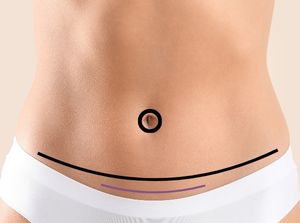
The “mini” abdominoplasty does not reposition the belly button (umbilicus). Skin excision and muscle tightening are limited to the area below the umbilicus.
During surgery, the umbilicus remains attached to the abdominal wall in the original position. The belly button is not altered in any way (i.e. no incision, no transposition).
Similar to traditional abdominoplasty, both long and short incision variations exist. The long incision variation permits greater skin excision. A short incision is possible when there is a minimum of excess skin and access is primarily needed to tighten the muscles.
Candidates for mini-abdominoplasty have limited volumes of excess skin confined to the lower abdomen. Often the incision is made just above the pubis and extends along the line of a “bikini” panty.
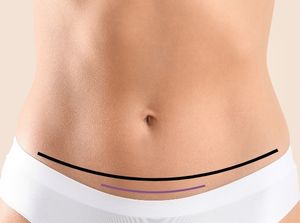
FAB is an acronym for floating umbilicus mini-abdominoplasty. It differs from a mini-abdominoplasty only in that the umbilicus is elevated from the abdominal bed permitting the entire length (pubis to rib margin) of the abdominal muscles to be tightened.
More specifically, a low abdominal incision is used for access. The umbilicus is “floated” by elevating the abdominal skin together with the belly button. After the entire midline muscular abdomen is tightened, the floating umbilicus is re-anchored back to its original anatomical position. A special surgical camera called an endoscope can be used to improve visualization of the muscle repair.
A “Fleur de Lys” abdominoplasty is also known as an inverted T abdominoplasty. This technique is mostly used in patients who have undergone bariatric surgery. Following massive weight loss, the skin excess is substantial. A fleur-de-lys abdominoplasty uses a 3-pointed-star pattern of skin excision centered around the umbilicus. Vast quantities of loose skin can be removed. Wound closure is in an inverted T pattern.
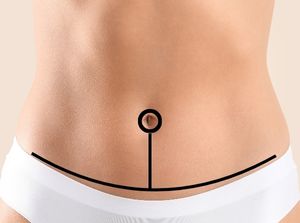
Tummy Tuck Considerations
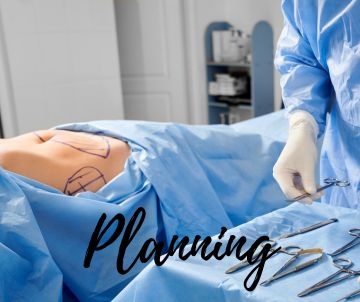
At Cosmetic Surgery Montreal, our plastic surgeon Dr. Chen Lee will evaluate your health and examine the unique details of your abdomen to formulate the most appropriate abdominoplasty technique to achieve your desired tummy contour. A written detailed list of risks and complications will be provided. We encourage you to read it.
If you wish to pursue surgery, routine laboratory tests are ordered to evaluate your fitness for general anesthesia and surgery.
Below are some basic recommendations to prepare for abdominoplasty:
- 1 month prior to surgery stop use of any tobacco or substances containing nicotine and do not resume until healed (usually 1 month after surgery)
- 1 month prior to surgery stop the use of all street drugs
- 2 weeks before surgery avoid the use of nonsteroidal anti-inflammatory medications (eg. Aspirin, Advil, Motrin, etc.)
- 5 days prior to surgery start stool softeners prescribed by Dr. Chen Lee
- In the evening and morning before surgery, shower with an acne soap such as Spectro-Jel
- It is important to fast (not eat or drink anything) after midnight before surgery
Dr. Chen Lee’s abdominoplasty patients are usually managed as ambulatory day surgery patients at Metropolitan Surgery Center in Montreal. Our patients should expect the following:
- Plan to be at the center for half a day.
- Arrive at the surgery center on time.
- The nursing team will greet and prepare you for safe surgery.
Abdominoplasty is usually performed under general anesthesia.
- To have a safe anesthetic, you must arrive at the surgery center in a fasted state (i.e. nothing by mouth 8 hours before surgery).
An abdominoplasty typically requires 2:00 to 3:00 of operative time.
- When you wake up, you will be taken to a recovery room.
- Once the anesthetic has worn off, you will be transferred to an observation unit for 1-2 hours before being discharged home.
Your safety is our utmost concern.
- You must be accompanied home by a trusted friend or family member.
- We recommend that they be present in your home for the early days following rhinoplasty.
Our office will call by telephone to periodically check on your progress at home. If you have an abdominal drain, our nurses will instruct you on how to empty and record the output. It will be removed at the first office visit 5-10 days after surgery.
- To reduce tension on the abdominal skin incision, try to maintain a sitting or semi-sitting position.
- Sleep with pillows behind the back and below the knees for the same reason.
- Take short walks inside your home. Move your legs and ankles to prevent phlebitis.
- Wear your abdominal compressive garment but be sure to adjust it every 4-6 hours for comfort.
- Take medications as prescribed.
- If an abdominal drain has been placed, the nurses will show you how to record the volume output and how to evacuate the drain.
Contact us immediately if:
- Bleeding
- Intense pain
- Fever
- Swollen and painful leg
Complications following abdominoplasty are infrequent. Obesity and a large pannus of excess abdominal skin are associated with a higher risk of complications.
Bleeding, infection, hematoma, and seroma are possible. If severe, go straight to the hospital emergency room hospital without delay.
Delayed wound healing and skin necrosis are complications that occur more often in obese patients and smokers. Wound complications are associated with increased scars.
Abdominoplasty scars are long. Fortunately, the scars often fade with time (>6 months) and are positioned low on the abdomen permitting concealment with clothing. Occasionally, scar revision is necessary. Surgical revisions are usually minor procedures performed under local anesthesia.
During your consultation, Dr. Chen Lee will answer your questions or concerns about complications. Our office will also provide you with a more comprehensive document listing the risks and complications associated with abdominoplasty.
Tummy Tuck Costs

The initial office consultation for an abdominoplasty is a wonderful opportunity to establish a healthy patient-surgeon relationship. During the consultation, the plastic surgeon will typically perform an evaluation for abdominal hernias, diastasis recti, and abdominal contours. Dr. Chen Lee tailors his recommended treatment to every patient’s unique situation. In addition, the risks associated with the recommended treatment will be explained in detail.
The patient, he/she should use this initial encounter to judge the professionalism and qualification of the doctor, as well as the quality of the information transmitted. With a comprehensive understanding of your goals, the plastic surgeon will be better able to achieve your objectives and make your abdominoplasty safe and satisfying.
The price of abdominoplasty in Montreal is quoted as a “global fee”. The price quote includes the costs of the surgeon, anesthesiologist, nurses, office visits during the first postoperative year, operating room, and surgical facility fees. Revisions and touch-up surgeries are not included in the initial abdominoplasty quotation. If general anesthesia is necessary, you will have to pay for the substantial costs associated with a surgical revision. Minor touch-up surgery under local anesthesia can often be performed at minimal expense.
Abdominoplasty pricing is proportional to its complexity. The price range for an uncomplicated typical abdominoplasty is $10,500 – $12,500 + taxes. Concurrent procedures such as liposuction are in addition to abdominoplasty pricing. More accurate pricing is possible only after a consultation with our plastic surgeon.
Our office requests payment in 2 equal installments. To reserve a date at the surgery center, we request an accompanying first installment (50% payment). The remaining balance is due 6 weeks before your scheduled date of surgery.
Surgeries are payable in cash, certified checks (bank drafts), or Interac. We also work with an independent credit company that offers financial payment plans for cosmetic surgery procedures. However, you should be aware that the interest rates and administration fees of this specialized company are higher than traditional financial institutions. It is often better to negotiate a loan through your personal bank or financial institution. We encourage you to do your homework and compare the true financial cost of these various financial options.
Most patients experience abdominal tightness and discomfort. The “tight” sensation will improve in 4-8 weeks after your tummy tuck. You will be supplied with an abdominal binder to wear for the first 6 weeks after surgery. It is important to make frequent adjustments to ensure that you do not develop wounds from garment friction and pressure points.
You will be encouraged to walk early after surgery. Ambulation significantly reduces the risk of phlebitis. Stool softeners will be prescribed to reduce the risk of constipation. We generally discourage physical exertion and lifting of heavy objects for 6 weeks.
Silicone scar treatment commences 3-6 weeks after surgery. The scar will gradually improve over a 6-month time duration. Revision of displeasing scars can be considered after 6 months.
FAQ – ABDOMINOPLASTY
It is natural to have questions about cosmetic surgery. We are committed to helping you understand the surgical considerations taken to plan an abdominoplasty procedure. Well-informed patients are better equipped to make decisions about tummy tuck surgery.
Individuals considering abdominoplasty surgery should be in good health, have no serious or active illnesses, no pre-existing medical conditions, and must have realistic outcome expectations. Abdominoplasty is not a treatment for obesity nor a substitute for good nutrition and exercise. Potential patients intending to lose weight should delay their tummy tuck procedure until they have reached a stable body weight. It is important to discuss pregnancy and weight loss plans with your plastic surgeon before surgery.
The preparation for abdominoplasty is very similar to the routine used with most cosmetic surgeries. Below are some basic recommendations used at Cosmetic Surgery Montreal to prepare for abdominoplasty:
- 1 month prior to surgery stop the use of any tobacco or substances containing nicotine and do not resume until fully healed
- 1 month prior to surgery stop the use of all street drugs
- 2 weeks before surgery avoid the use of nonsteroidal anti-inflammatory medications (eg. Aspirin, Advil, Motrin, etc.)
- 5 days prior to surgery start stool softeners were prescribed by our plastic surgeon, Dr. Chen Lee.
- In the evening and morning before surgery, shower with an acne soap such as Spectro-Jel
- it is important to fast (not eat or drink anything) after midnight before surgery
Most tummy tucks are performed under general anesthesia on ambulatory outpatients. Our plastic surgeon usually requires 2 to 3 hours of operative time to perform a routine abdominoplasty. However, you should plan to be occupied for a half-day at the surgical center.
We routinely scheduled tummy tucks in the morning to provide ample time for your recovery under medical supervision. Your requested time of arrival at the surgical center is well in advance of the scheduled time of operation. This gives our nurses time to confirm that they are medically fit and properly prepared for safe surgery.
After surgery, you will be monitored in the recovery room. You will be discharged only when the effects of the anesthesia have worn off. For safety, a responsible person (family member or friend) must be present to accompany you on your return trip home. After general anesthesia, it is not sufficient nor safe to leave the surgery center by taxi without the accompaniment of a responsible person.
Most patients experience abdominal tightness and discomfort. The “tight” sensation will improve in 4-8 weeks after your abdominoplasty. You will be supplied with an abdominal binder to wear for the first 6 weeks after surgery. It is important to make frequent adjustments to ensure that you do not develop wounds from garment friction and pressure points.
You will be encouraged to walk early after surgery. Ambulation significantly reduces the risk of phlebitis. Stool softeners will be prescribed to reduce the risk of constipation. We generally discourage physical exertion and lifting of heavy objects for 6 weeks.
Silicone scar treatment commences 3-6 weeks after surgery. The scar will gradually improve over a 6-month time duration. Revision of displeasing scars can be considered after 6 months.
Tummy tuck surgery is effective at removing excess abdominal skin below the umbilicus. If your stretch marks are below the umbilicus, the likelihood is high that an abdominoplasty will remove the affected skin. However, stretch marks positioned above the umbilicus or near the hip will still remain following a tummy tuck procedure.
Perhaps. Remember, if you are overweight, the remaining residual fat on the skin will prevent you from having a flat abdominal contour despite having a tummy tuck. Even thin individuals in a sitting position will have some loose skin and fat.
Tummy tuck procedures are especially effective at treating excessively loose abdominal skin. Liposuction is best used in normal skin with an underlying fat excess eg. abdominal “love handles” and hip “saddlebags”. Liposuction is not a customary component of a tummy tuck procedure. Nevertheless, it is commonly performed concurrently with a tummy tuck.
At Cosmetic Surgery Montreal, our concurrently performed liposuction is priced according to its magnitude as well as the extended duration of time expected under general anesthesia. More precise details on concurrent liposuction prices can be obtained only after consultation with our plastic surgeon.
Gentle ambulation is encouraged in the early days after abdominoplasty. Walking significantly reduces the risk of blood clots in the legs. Light household chores are usually possible 3 weeks after abdominoplasty. Intense physical exertion and lifting of heavy objects are to be avoided for 6 weeks. After 6 weeks, an exercise program with a gradual and progressive increase in intensity can be commenced. Return to unrestricted full-intensity sports activities can usually be achieved by the 12th week after abdominoplasty surgery.
The portion of skin and fat removed with a tummy tuck will never grow back. Even with weight gain, there remains a permanent reduction of skin and subcutaneous tissue. However, the fat cells within the remaining tissues of the abdomen will enlarge with weight gain and may stretch the abdominal skin resulting in the loss of some of the previous cosmetic benefits of a tummy tuck.
We recommend planning your abdominoplasty after you have finished having all of your children. Despite this recommendation, pregnancy after abdominoplasty does happen. Skin is an elastic organ capable of adaptation to stretch. Those who choose to carry their pregnancy to full-term are usually able to undergo labor and childbirth without difficulty.
The cosmetic effect of pregnancy on a previously tummy-tuck-treated abdomen is less predictable. There is no guarantee that the previous benefits of abdominoplasty will persist following a full-term pregnancy. Redo tummy tuck may be necessary to regain that flat abdomen.
Preparation for Abdominoplasty
- Avoid nonsteroidal anti-inflammatory medications (Aspirin, Advil, etc.)
- Stop smoking, do not use e-cigarettes, avoid nicotine and marijuana
- Do not drink alcohol
- Continue prescription medications (unless advised otherwise)
Day of Surgery
- Stay fasted from midnight prior to surgery (no food, no drinks)
- Be punctual – Arrive on time at the surgery facility
- Wear loose clothing – Avoid the use of cosmetics
- Come accompanied by a responsible person (transportation home)
Advice after Abdominoplasty
- Do not cook, clean, carry weight (groceries or children), or drive
- Take your medications as prescribed
- Notify us promptly of unexpected symptomatology
- Do your best to rest and relax for 2 weeks



